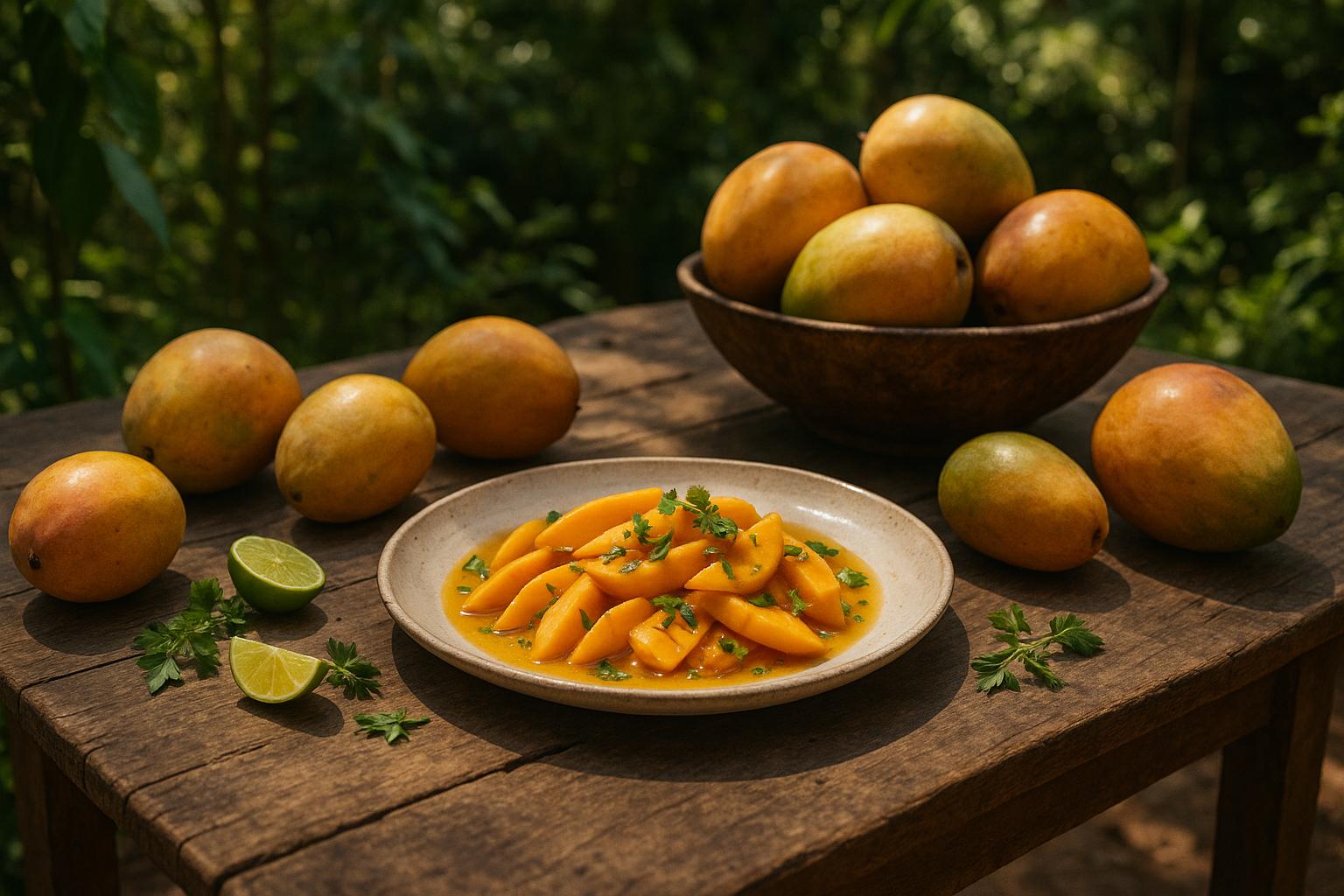Haitian cuisine is a flavorful blend of French techniques, African traditions, and local ingredients. Here’s what you need to know:
- French Culinary Roots: French colonists introduced cooking methods like gratinée and fricassée, along with ingredients such as butter, sugar, and wheat.
- African and Indigenous Fusion: Enslaved Africans and local cooks reimagined French methods with spices, tropical ingredients, and one-pot cooking styles.
- Modern Haitian Dishes: Classics like Soup Joumou (a symbol of independence), Pâtés Haïtiens, and Griot combine French methods with bold Haitian flavors.
- Key Techniques: Haitian epis (a spiced herb paste) is a twist on French mirepoix, and slow cooking and stewing remain central to many dishes.
- French Influence Today: French cheeses, breads, and desserts are still found in Haitian markets, and upscale restaurants blend French artistry with Haitian flavors.
Haitian food isn’t just about taste - it’s a living history of resilience and creativity, blending French roots with a distinctly Haitian identity.
Haitian cuisine | Wikipedia audio article
How French Colonial History Shaped Haitian Food
By the 1700s, French colonists had taken control of Hispaniola, turning Haiti into France's wealthiest colony. This shift not only transformed the island's agriculture but also laid the groundwork for a unique culinary fusion, blending French techniques with African and local influences.
During the colonial era, French settlers reshaped Haiti's agricultural landscape by cultivating sugarcane, coffee, cotton, and cocoa through the labor of enslaved people. These crops were primarily grown for export but also became staples in local cuisine. French ingredients like eggs, sugar, butter, and wheat were introduced, enriching Haitian recipes and inspiring new culinary traditions. Desserts and pastries, like the beloved pain patate, reflect this blend of French baking techniques with local flavors. Sugar, once a cornerstone of Haiti's export economy, became a key ingredient in traditional sweets and preserves, showcasing how French agricultural practices intertwined with local cooking.
How Enslaved Africans Changed French Cooking
In Haitian kitchens, enslaved Africans adapted French culinary methods by incorporating local ingredients such as okra, taro, and pigeon peas - ingredients deeply rooted in African cooking traditions. This blending of techniques and flavors created something entirely new. As Chef and Culinary Historian John Folse notes:
"When we talk about the influence of the islands in general, especially Haiti, we cannot help but think that they've formed the cooking styles of the Africans that eventually made their way into the kitchens of New Orleans".
These innovations not only transformed Haitian cuisine but also left a lasting mark on culinary traditions far beyond the island.
French Methods That Stayed After Independence
Despite gaining independence in 1804, Haiti retained many French culinary influences. French cheeses, breads, and desserts remain popular in Haitian markets today. French cooking techniques, too, continue to shape how Haitians prepare their meals. A prime example of this enduring influence is found in gratin dishes. Sunday lunches often feature a gratin, with pasta gratin (a Haitian take on macaroni and cheese) standing out as a favorite. This dish combines classic French methods with locally available ingredients, creating a comforting and distinctly Haitian staple.
The continued presence of these French elements in Haitian cuisine underscores how colonial-era practices evolved into a rich culinary identity - one that celebrates both French heritage and African creativity.
French Cooking Methods in Haitian Kitchens
French culinary techniques underwent a transformation in Haiti, blending with local ingredients and African traditions to create a unique and vibrant cuisine. Haitian cooks continue to draw on these methods, adapting them to reflect the flavors and ingredients of their homeland. Let’s explore how these techniques have been reimagined in Haitian kitchens.
Epis: Haiti's Take on French Mirepoix
Haiti's culinary history, shaped by its French colonial past, gave rise to epis, a flavorful twist on the French mirepoix. In French cooking, mirepoix - a simple mix of diced onions, carrots, and celery - serves as the aromatic foundation for many dishes. Haitian cooks took this idea and elevated it, crafting a bolder, more intricate blend of herbs and spices.
As Chef Alain Lemaire explains:
"But the quintessential element in Haitian cuisine is bar none, epis. Epis is a blend of herbs and spices that is used in almost all Haitian dishes. It consists predominantly of thyme, garlic, parsley, scallions, scotch bonnet peppers, cloves, and garlic."
This vibrant seasoning, often described as "a confetti-colored building block of flavor", is central to Haitian cooking. Chef Nadege Fleurimond highlights its significance:
"Haitian food has distinct flavors, ingredients, and techniques, such as our use of epis (a blend of herbs and spices) and unique dishes like Soup Joumou and Diri Djon Djon."
Haitian cooks blend ingredients like fresh thyme, garlic, parsley, scallions, scotch bonnet peppers, and cloves into a paste. This versatile mixture is used to season rice, marinate meats, and enhance stews, making it a defining feature of Haitian cuisine.
Slow Cooking and Stewing Techniques
French methods of braising and slow cooking found a natural home in Haitian kitchens, merging seamlessly with the country's traditional one-pot cooking practices. Haitian dishes like fricassée showcase this fusion, combining the French approach of browning and slow-cooking with Haitian spices and seasonings.
One standout example is Légume Haïtien, a hearty vegetable stew slow-cooked with spices, onions, garlic, tomato paste, and either beef or crab. Another is Poul an sòs (chicken in sauce), where the chicken is first seared - following classic French techniques - before being simmered to create a richly flavored dish.
These adaptations demonstrate how French culinary traditions have been infused with Haitian flair, resulting in dishes that are both comforting and full of character.
French-Style Bread Making in Haiti
French bread-making techniques, introduced during Haiti's colonial era, have also been reinterpreted to suit local tastes and ingredients. While Haitian pain de mie resembles the French baguette, many Haitian breads have evolved into something entirely different.
Haitian bakers often incorporate cornmeal, rice, or barley - grains not typically found in French bread recipes. The result is a denser bread, with vegetable oil or shortening replacing butter. One example is Pain Patate, which combines French kneading and rising techniques with locally inspired grains, creating a unique texture and flavor.
Some bread names still reflect their French roots. For instance, Coco bread stems from the French word "cocotte", meaning pastry, while flanbé combines "flan" and "beurre" (French for butter). These breads often feature spices like cinnamon, nutmeg, and anise, along with tropical fruits, resulting in flavors that celebrate Haiti's ingenuity while honoring its French culinary heritage.
From bold seasoning blends to hearty stews and breads, Haitian cuisine continues to build on French techniques, creating dishes that are unmistakably Haitian yet deeply rooted in their historical influences.
Popular Haitian Dishes with French Origins
Haitian cuisine is a vibrant tapestry of flavors, shaped by the blending of French techniques, African influences, and local ingredients. Here are three standout dishes that showcase this rich culinary heritage.
Soup Joumou: A Taste of Independence
Soup Joumou is more than just a meal - it's a symbol of Haiti's hard-won freedom. This hearty soup, made with squash, beef, vegetables, and a mix of Haitian spices, is traditionally served on January 1st to mark the country's independence from French colonial rule in 1804. The dish is a poignant reminder of resilience, as Haitian cooks took French culinary methods and infused them with local flavors to create a meal that celebrates liberation and cultural pride.
Pâtés Haïtiens: Layers of Flavor
Pâtés Haïtiens are a delicious example of how French puff pastry techniques have been reimagined in Haitian kitchens. These flaky pastries are filled with savory options like spiced meat, cod, or smoked herring. The combination of delicate, buttery layers with boldly seasoned fillings creates a snack that's both comforting and full of character, making it a favorite across Haiti.
Griot: A Bold Reinvention
Griot is a standout dish that marries the French confit technique with the boldness of African-inspired spices. Using the confit method - slow-cooking pork in its own fat - Haitian cooks create tender, flavorful meat. The name "griot" hints at "grillage" (grilling or roasting), which gives the dish its signature crispy finish. This fusion of methods and flavors turns a colonial cooking style into a dish that's unmistakably Haitian.
These dishes are just a glimpse into how Haitian cuisine transforms French culinary roots into something uniquely its own, celebrating bold flavors and a rich history.
sbb-itb-80c33ff
French Influence in Today's Haitian Cooking
Haitian cuisine thrives as a vibrant blend of flavors and techniques, deeply rooted in a history of cultural fusion. The French culinary legacy, in particular, plays a lasting role, shaping how Haitian dishes are prepared and presented today. From the bustling streets of Port-au-Prince to the eclectic dining scenes in cities like Miami, chefs are merging traditional French methods with bold Haitian ingredients to create dishes that celebrate both traditions.
Upscale Restaurants in Haiti
Haiti’s fine dining scene has embraced French culinary artistry, combining it with the rich, authentic flavors of the island. In upscale restaurants, you’ll often find French-inspired plating techniques paired with local ingredients. Staples like French cheeses, freshly baked artisanal breads, and delicate desserts are common, reflecting the enduring influence of French gastronomy on Haitian cuisine.
Chef Albertho, a Haitian immigrant and culinary artist, exemplifies this movement. By applying French fine dining principles to Haitian classics, he’s challenging outdated perceptions of Haitian food.
"I want to showcase that you can create beautiful art with food and flavors that are unique to Haiti. Most people don't think of fine dining when they think of Haitian food - but I want to change that! I want people to feel proud to go on a date at a Haitian restaurant. Right now, you wouldn't exactly go out for a nice meal at a Haitian restaurant with your significant other. But, when I bring artistry to the table with Haitian flavors, the food transforms into an elevated yet authentic experience." - Chef Albertho
This innovative approach is reshaping not only local dining but also perceptions of Haitian cuisine worldwide.
French-Haitian Fusion in America
In Haitian-American communities, the fusion of French techniques, Haitian spices, and American favorites has created a new wave of culinary innovation. Miami, in particular, has emerged as a hub for this creativity, with restaurants serving dishes that surprise and delight both French and Haitian palates.
Some standout creations include Haitian-Korean tacos, which combine the tangy heat of pikliz with kimchi, and Haitian breakfast burritos, loaded with scrambled eggs, black beans, fried plantains, and spicy slaw. These dishes highlight how Haitian flavors and French methods can seamlessly adapt to new culinary traditions.
Food trucks like Chateau Creole are also making these fusion dishes more accessible. By offering Haitian-inspired empanadas and tacos, they’re introducing diverse audiences to the unique blend of French-influenced Haitian flavors - all from the convenience of a mobile kitchen.
Cooking Classes and Food Tours
As these fusion dishes gain popularity, there’s growing interest in learning the techniques behind them. Cooking classes have become an engaging way to explore the French-African-indigenous blend that defines Haitian cuisine. Participants not only learn recipes but also the history and traditions behind them.
These classes often focus on dishes like Diri Kole and Poulet Creole, which showcase the fusion of African, French, and Taíno influences. Students get hands-on experience with French techniques such as gratinée and fricassée, adapted to incorporate Haiti’s tropical ingredients and bold flavors.
Conclusion: French Influence Lives On in Haitian Food
The fusion of French techniques with African, Indigenous, and Caribbean traditions has shaped a cuisine that embodies Haiti’s rich cultural identity. This blend of influences stands as a testament to the resilience and resourcefulness of the Haitian people, who turned historical adversities into vibrant expressions of community and pride.
This legacy thrives in every traditional Haitian dish. Take Soup Joumou, for example - a dish deeply symbolic of Haiti’s independence. Served every January 1st, it celebrates the nation’s triumph over colonial oppression and honors its enduring spirit.
But Haitian food is more than just recipes; it’s a way of preserving history and uniting communities, both at home and across the diaspora. As Nadege Fleurimond, a cookbook author and restaurateur, puts it:
"It is the way we honor our history, celebrate life, and connect with each other. It's not just about food - it's about storytelling, pride, and preserving a legacy that blends African, Indigenous, French, and Caribbean influences."
Passing down recipes and techniques, like the French-inspired art of slow braising, does more than keep traditions alive - it strengthens bonds and keeps the connection to Haitian heritage intact. These culinary practices ensure that the stories, rituals, and values behind each dish are not lost but shared with future generations.
Chef Alain Lemaire, owner of Sensory Delights, emphasizes this connection between food and culture:
"Understanding the landscape of Haitian culture is very important in understanding Haitian cuisine. As mentioned before, each dish has a story. Some Haitian dishes stem from rituals, spirituality, and connecting with nature."
The French influence in Haitian cuisine is not a relic of the past - it’s a living, breathing part of the nation’s culinary evolution. As more people explore the bold flavors and refined techniques that define Haitian cooking, they’re engaging with a legacy born from resilience and creativity. This ongoing dialogue between cultures reminds us that blending traditions can result in something far greater than the sum of its parts. Haitian cuisine, with its French roots and multifaceted identity, continues to tell a story of strength, unity, and celebration.
FAQs
How has French influence shaped Haitian cuisine over time?
French influence has deeply shaped Haitian cuisine, intertwining traditional French techniques with local ingredients and African culinary traditions. During the French colonial period in the 17th and 18th centuries, French cooking methods and ingredients found their way to Haiti, blending with the flavors and practices brought by enslaved Africans and the native Taino people.
This unique combination led to the creation of beloved Haitian dishes like pâtés (savory pastries) and pain patate (sweet potato pudding). These dishes are perfect examples of French culinary techniques harmonizing with distinctly Haitian ingredients and flavors. Even today, French gastronomy continues to play a significant role in Haiti's culinary identity, influencing everything from baking styles to the use of aromatic spices in contemporary Haitian cooking.
How has Haitian cuisine blended French cooking techniques with local flavors and ingredients?
Haitian Cuisine: A Fusion of French Techniques and Caribbean Flavors
Haitian cuisine is a delightful harmony of French culinary methods and the bold, vibrant ingredients of the Caribbean. Techniques like fricassee and gratin have been infused with local staples such as scotch bonnet peppers, fresh herbs, and tropical spices. The result? Dishes that burst with flavor and offer a distinctive twist on classic preparations.
French pastry-making has left its mark on Haitian cooking as well. Take pâtés, for instance - savory pastries that combine the finesse of French baking with Haitian flair. Or pain patate, a sweet potato pudding that blends traditional baking techniques with ingredients like sweet potatoes, cinnamon, and nutmeg. These dishes beautifully showcase how Haitian cooks have embraced French culinary traditions while celebrating the island’s rich and flavorful identity.
What is 'epis,' and how does it compare to the French 'mirepoix' in cooking?
Epis vs. Mirepoix: A Tale of Two Flavor Bases
Epis is the heart and soul of Haitian cooking, a lively and aromatic mix that breathes life into every dish it touches. Crafted from a blend of fresh herbs, garlic, peppers, and a medley of seasonings, this spice mix is all about bold, punchy flavors. Whether it's stews, soups, or marinades, epis is made fresh and often customized to suit the recipe at hand, ensuring every dish carries its unique zing.
On the other hand, the French mirepoix takes a more understated approach. This classic trio of diced onions, carrots, and celery is gently cooked in fat, coaxing out a subtle sweetness that forms the foundation for stocks, soups, and sauces. Where epis delivers a vibrant, spicy kick, mirepoix leans into soft, mellow notes, reflecting the refined elegance of French culinary traditions. Together, they highlight the distinct ways cultures build flavor, each with its own delicious charm.


